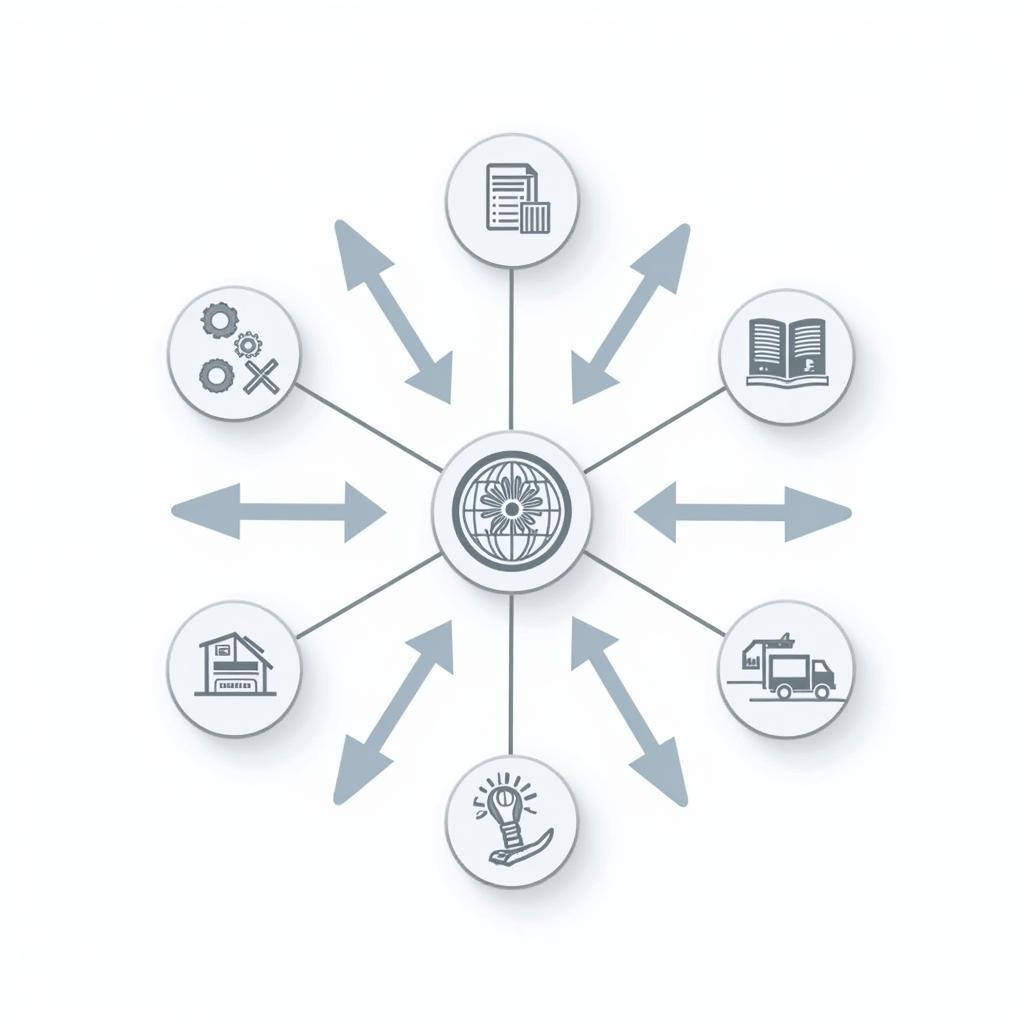The Association of Southeast Asian Nations (ASEAN) is a regional intergovernmental organization that promotes economic, political, security, military, educational, and sociocultural integration amongst its ten member states. Since its formation in 1967, ASEAN has operated on a framework built upon collaboration in eight key areas. This article delves into the significance of each area, highlighting how they contribute to ASEAN’s overall development and regional integration.
1. Economic Cooperation: The Cornerstone of ASEAN Integration
ASEAN’s commitment to economic cooperation is arguably its most defining feature. The region recognizes that economic growth is fundamental to improving the lives of its citizens. Key initiatives in this area include:
- ASEAN Free Trade Area (AFTA): Established in 1992, AFTA aims to eliminate tariffs and non-tariff barriers to trade between member states, fostering a single market and production base.
- ASEAN Comprehensive Investment Agreement (ACIA): This agreement encourages greater investment flows within the region by providing a more liberal and transparent investment environment.
- ASEAN Economic Community (AEC) Blueprint 2025: Launched in 2015, this blueprint outlines the roadmap for achieving a highly integrated and cohesive economy by 2025, focusing on areas such as trade facilitation, innovation, and digital economy.
 ASEAN Economic Integration
ASEAN Economic Integration
2. Political-Security Cooperation: Maintaining Regional Peace and Stability
A peaceful and stable environment is crucial for economic development and prosperity. ASEAN recognizes this and has prioritized political-security cooperation through various platforms:
- ASEAN Political-Security Community (APSC): This pillar aims to address traditional and non-traditional security challenges through dialogue, confidence-building measures, and preventive diplomacy.
- Treaty of Amity and Cooperation in Southeast Asia (TAC): This treaty, signed in 1976, binds ASEAN members to peaceful co-existence and non-interference in each other’s internal affairs.
- ASEAN Regional Forum (ARF): This forum serves as a platform for dialogue on security issues involving ASEAN and its dialogue partners, which include major powers like the US and China.
3. Socio-Cultural Cooperation: Fostering a Shared ASEAN Identity
Beyond economics and politics, ASEAN recognizes the importance of nurturing a shared regional identity. This involves promoting cultural exchange, enhancing people-to-people connectivity, and addressing social issues:
- ASEAN Socio-Cultural Community (ASCC): This pillar focuses on improving the quality of life for ASEAN citizens through collaboration in areas like education, health, social welfare, and environmental protection.
- ASEAN University Network (AUN): Established in 1995, the AUN facilitates collaboration among leading universities in the region to enhance the quality of education and research.
- ASEAN Youth Cooperation: This initiative promotes youth leadership, volunteerism, and cross-cultural understanding among young people in the region.
4. Functional Cooperation: Addressing Transnational Challenges
The interconnected nature of the modern world requires ASEAN to collaborate on a wide range of functional areas to address transnational challenges:
- Disaster Management: ASEAN has established mechanisms to coordinate disaster relief efforts and share best practices in disaster preparedness and response.
- Transnational Crime: The region works together to combat terrorism, drug trafficking, human trafficking, and other transnational crimes through information sharing, capacity building, and joint operations.
- Climate Change: ASEAN has adopted various initiatives to address the impacts of climate change, such as promoting renewable energy, sustainable forest management, and climate-resilient agriculture.
 ASEAN Disaster Relief
ASEAN Disaster Relief
5. External Relations: Engaging with the World
While focused on regional integration, ASEAN also actively engages with the international community to promote peace, stability, and prosperity:
- Dialogue Partners: ASEAN maintains dialogue partnerships with countries and organizations outside the region to foster cooperation in areas of mutual interest.
- ASEAN Plus Three (APT): This forum brings together ASEAN, China, Japan, and South Korea to discuss regional economic and financial cooperation.
- East Asia Summit (EAS): This forum provides a platform for strategic dialogue and cooperation on key regional and global issues involving ASEAN and its dialogue partners.
6. Narrowing the Development Gap: A Commitment to Inclusivity
ASEAN is committed to ensuring that all member states benefit from regional integration. Initiatives in this area include:
- Initiative for ASEAN Integration (IAI): Launched in 2000, the IAI aims to narrow the development gap between ASEAN member states by providing assistance to Cambodia, Laos, Myanmar, and Vietnam (CLMV countries).
- Master Plan on ASEAN Connectivity (MPAC): This plan aims to enhance physical, institutional, and people-to-people connectivity within ASEAN to facilitate the flow of goods, services, investment, and people.
7. Science and Technology Development: Embracing Innovation
Recognizing the importance of science and technology in driving economic growth and development, ASEAN focuses on:
- ASEAN Plan of Action on Science, Technology, and Innovation (APASTI): This plan outlines the framework for cooperation in areas such as biotechnology, nanotechnology, and information and communication technology (ICT).
- ASEAN Science and Technology Fellowship Programme: This program aims to develop a pool of highly skilled scientists and researchers in the region.
8. Small and Medium Enterprises (SMEs) Development: Supporting the Backbone of the Economy
SMEs play a crucial role in ASEAN’s economy, accounting for a significant portion of employment and GDP. Recognizing their importance, ASEAN has implemented various initiatives to support their growth:
- ASEAN SME Strategic Action Plan 2016-2025: This plan aims to enhance the competitiveness and innovation of SMEs in the region.
- ASEAN SME Academy: This online platform provides SMEs with access to training, mentoring, and networking opportunities.
Conclusion: ASEAN’s 8 Areas of Cooperation – A Catalyst for Progress
The 8 areas of cooperation form the bedrock of ASEAN’s success as a regional organization. By working together in these key areas, ASEAN member states have made significant strides in promoting economic growth, maintaining peace and security, and improving the lives of their citizens. As ASEAN continues to evolve, these areas of cooperation will remain crucial in navigating the challenges and opportunities of the 21st century.
FAQs: Understanding the 8 Areas of ASEAN Cooperation
1. What is the main goal of ASEAN’s economic cooperation?
ASEAN aims to achieve economic integration through initiatives like AFTA and the AEC Blueprint, fostering a single market and production base, promoting trade and investment, and enhancing regional competitiveness.
2. How does ASEAN address security threats?
ASEAN utilizes platforms like the APSC and ARF to facilitate dialogue, build confidence, and promote preventive diplomacy to address both traditional and non-traditional security challenges.
3. What is the role of socio-cultural cooperation in ASEAN?
Socio-cultural cooperation aims to foster a shared ASEAN identity by promoting cultural exchange, enhancing people-to-people connectivity, and addressing social issues through initiatives like the ASCC and ASEAN University Network.
4. Why is functional cooperation important for ASEAN?
Functional cooperation allows ASEAN to address transnational challenges that transcend national borders, such as disaster management, transnational crime, and climate change, through collaborative efforts and information sharing.
5. How does ASEAN engage with the international community?
ASEAN actively engages with the world through dialogue partnerships, forums like ASEAN Plus Three and the East Asia Summit, promoting cooperation and dialogue on regional and global issues.
6. How does ASEAN promote inclusive development?
ASEAN is committed to narrowing the development gap between its member states through initiatives like the IAI and MPAC, ensuring that all countries benefit from regional integration.
7. Why is science and technology development a priority for ASEAN?
ASEAN recognizes the importance of science and technology in driving economic growth and development, promoting collaboration and innovation through initiatives like APASTI and the ASEAN Science and Technology Fellowship Programme.
8. How does ASEAN support the growth of SMEs?
ASEAN has implemented various initiatives to support the growth of SMEs, such as the ASEAN SME Strategic Action Plan and the ASEAN SME Academy, recognizing their significant contribution to the region’s economy.
For further information and support, please contact us:
Phone Number: 0369020373
Email: aseanmediadirectory@gmail.com
Address: Thon Ngoc Lien, Hiep Hoa, Bac Giang, Vietnam
Our dedicated customer service team is available 24/7 to assist you. You can also find more insights on ASEAN topics through these valuable resources:
We encourage you to explore our website for a wider range of articles and information on ASEAN.
